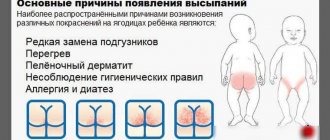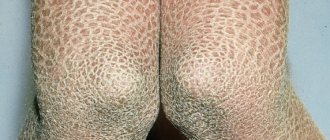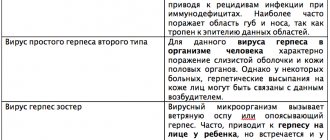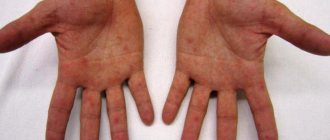Rubella is a disease of viral etiology, which is mostly characteristic of pediatric patients. This togavirus affects children under 6-7 years of age and is not considered a severe disease. It's a different matter for adults. All signs, both primary and secondary, in people who become ill in adulthood are expressed much more clearly, and the illness is much more severe.
Signs of rubella in adults
What is rubella?
First, it’s worth understanding what rubella is, what the routes of infection are, and what the primary signs are.
Rubella is a viral disease that most often affects children aged 2-10 years. This infection itself is not dangerous, but it poses a threat to pregnant women, since the virus in 90% of cases leads to various defects in the fetus.
Rubella appears in the form of bright pink rashes, accompanied by low-grade fever.
Nature of the rash
Rubella rash has its own specific characteristics and manifestations. The size of the rash varies between 2-4 mm. The spots are round in shape and red or bright pink in color. They are located separately and rarely merge. The rashes, as a rule, are first localized on the face, then spread to the entire body, legs and arms.
A maculopapular rash is a combination of flat, red spots that may be slightly raised above the skin. Distinctive features of the rashes are that they do not merge, which makes it possible to distinguish rubella from other childhood diseases, in particular measles and meningitis.
Rubella rash is characterized by the following characteristics:
- the spots are small in size;
- the rashes are quite profuse;
- the rash, as a rule, is localized mainly on the extensor parts of the arms, legs, face, buttocks;
- in most cases, the spots are single and do not merge;
- spots lose brightness quite quickly;
- rashes appear at one moment and are no longer added.
The rash quickly spreads throughout the body and disappears without a trace, leaving no scars, pigmentation, or peeling, as is the case with chickenpox.
Rubella during pregnancy
Despite the fact that rubella is easy in children, getting it during pregnancy is extremely dangerous.
Read here! Hyperthyroidism - description of effective treatment and useful information on how to cure the thyroid gland (135 photos)
In the first weeks of pregnancy, the child develops all the basic systems. The rubella virus that enters the body during this period can lead to miscarriage or the need to terminate the pregnancy for medical reasons.
If a woman has been vaccinated against rubella, there is a chance that the child will be healthy.
Diagnostics
Rubella in adults usually does not require careful diagnosis: a characteristic rash allows you to quickly determine the pathology.
Laboratory confirmation of the disease is required if it is difficult to differentiate it from:
- Scarlet fever.
- Allergic reaction.
- Corey.
The study is mandatory for pregnant patients, since in their case the risk of complications reaches an absolute maximum.
Diagnostics includes studies:
- Serological ELISA method: enzyme immunoassay in blood for the presence of antibodies produced by the body to fight the virus.
- Polymerase chain reaction (PCR), when the RNA of the virus is detected in the blood.
Both methods are approximately equal in efficiency, but PCR gives a more accurate result, since it is not affected by the state of the immune system, and there is no need to wait until class M and G antibodies are produced.
Complications after rubella
Complications are very rare and mainly occur in children with reduced immunity.
The most common are otitis media and pneumonia; in more serious cases, meningitis and encephalitis may result.
Treatment methods
Diagnosis of diseases is simple, it is carried out on the basis of the clinical picture.
If the diagnosis is questioned, then serological tests are carried out as laboratory tests, which show the presence of antibodies in the blood to certain groups of viruses. Making a correct diagnosis helps:
- make a decision to isolate the patient from society;
- avoid possible complications;
- carry out prevention;
- prescribe treatment procedures.
Typically, viral infections are practically untreatable, so there is no specific drug therapy regimen. In childhood, the disease is easily tolerated and requires only the parents' attentive attitude to the baby's condition. Treatment is limited to relieving the painful manifestations of the disease.
During the treatment process the following is carried out:
- Hospitalization in case of complications or severe form of the disease. In mild cases, the patient recovers at home, where he is periodically observed by a doctor.
- Monitoring your diet, which should be light, nutritious, and fortified. It is recommended to drink plenty of fluids, preferably acidified.
- Installation of bed rest or gentle rest, limiting physical activity and nervous shock.
- Treatment with antipyretics, sedatives and antihistamines if the disease is severe.
After an illness, the body remains weakened for 2 weeks or a month, so if a child is sick, he needs isolation so as not to contract a new infection.
Some parents self-medicate, prescribing antibiotics to their children without medical advice. This is dangerous because antibiotics affect bacteria and do not affect viruses.
Rubella vaccine
The only and surest way to avoid complications or complex course of the disease is vaccination against rubella. The vaccine is administered twice. The first time - at a year or a year and a half, the second time - at 6 years. If the child has not received the vaccine during this period, it can be done at any age.
It is advisable for girls to be vaccinated before planning pregnancy.
The vaccine may cause minor side effects, such as fever, minor rash, and swollen lymph nodes.
All these symptoms disappear in 5-7 days, and immunity from this virus remains for 10-20 years and the likelihood of infection is significantly reduced.
Stages of the disease
The course of the disease is divided into several stages:
- Incubation period. At this time, the patient does not have any clinical manifestations, but infection has already occurred and the virus is in the body.
- Prodromal period.
- Skin rashes.
- Recovery.
During the prodromal period, nonspecific symptoms are observed - weakness, fever, swelling of the lymph nodes. Adults often experience joint pain. They can enlarge and become inflamed. After recovery, the discomfort disappears, and the functions of the joints are normalized.
During the period of skin rashes, a specific red, bright pink rash appears. Local reddening of the mucous membranes - soft, hard palate, arches - may also be observed.
Note! The rash first appears on the neck, face, and then spreads to the entire body during the day. On the second day, the rashes lose their brightness and turn pale. On the third day they become scarce, decrease in size and persist only in certain places, after which they disappear, leaving no traces. Minor skin pigmentation may persist for some time.
When a rash appears, the temperature can reach up to 39 degrees. In some situations it remains within normal limits. There is an increase in lymph nodes and a deterioration in the patient’s well-being.
How does rubella in adults differ from rubella in children?
- Higher temperature
- The rash is brighter, sometimes forming large red spots
- Sharp enlargement of lymph nodes
- Migraine
- Signs of severe intoxication, including dehydration.
general information
Rubella is an infectious disease caused by a special group of viruses from the Rubivirus genus. First, pathogens enter the child’s body through the upper respiratory tract.
Next, the viruses move to the lymph nodes, where they multiply and accumulate in large quantities. They then enter the bloodstream and spread throughout almost the entire body.
The disease is expressed in such main symptoms as enlarged lymph nodes and a rash throughout the body. The immune system is able to cope with the viruses of this infection on its own. Children who have recovered from the disease acquire stable, lifelong immunity against this disease.
Thanks to widespread vaccination of children, cases of the disease are extremely rare. Babies can be vaccinated as early as 1 year of age. Therefore, children from 2 to 7 years of age who have not been vaccinated most often get sick, and in rare cases, children under one year of age.
Photo of rubella
Please repost
0
Forecast and preventive measures
The prognosis of the disease is encouraging. The child recovers completely and acquires immunity against infection for life. A rare exception is the case of the development of such a severe complication as encephalitis, which can be fatal.
Prevention is timely vaccination . When are children vaccinated against rubella? Babies receive their first one at one year of age. Immunity to the disease appears within 21 days after the first administration of the vaccine. After 6 years, re-vaccination is carried out.
Another important preventive measure is following the rules of personal hygiene, which must be taught to children from a very early age.
Although rubella is considered a harmless infection, it should not be underestimated. To eliminate all possible risks, it is important to vaccinate your child in a timely manner. This way the baby will be completely protected from infectious diseases.
Find out more useful information on the topic from the video clip:











